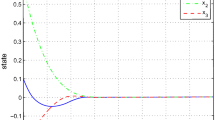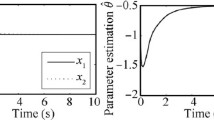Abstract
This study presents a design method for port-controlled Hamiltonian system, in which the nonlinear control is decomposed into the stabilization control at given equilibrium and additional L 2 adaptive control. The stabilization controller includes the simplified object model, which is the internal model controlling the conception expansion in nonlinear case. The errors arising from parameters and modelling are evaluated using the weighing matrix of the penalty function, which simplifies the design procedure of control. The L 2 adaptive control law is feedback control of the output errors with weighting matrix, which is the key character of the adaptive control. The proposed decomposing and simplifying method of the control law can be easily applied to investigate the higher order system. The procedure of control design and the issues associated with the application of control law are demonstrated by taking the hydro turbine generating system as an example. Simulation shows that the proposed method is very stable and robust.
Similar content being viewed by others
References
R. Ortega, A. J. van der Schaft, I. Mareels, and B. Maschke, “Putting energy back in control,” IEEE Control Systems Magazine, vol. 21, no. 2, pp. 18–33, April 2001.
R. Ortega, A. J. van der Schaft, B. Maschke, and G. Escobar, “Interconnection and damping assignment passivity-based control of port-controlled Hamiltonian systems,” Automatica, vol. 38, no. 4, pp. 585–596, 2002.
R. Ortega, A. J. van der Schaft, F. Castanos, and A. Astolfi, “Control by interconnection and standard passivity-based control of port-Hamiltonian systems,” IEEE Trans. on Automatic Control, vol. 53, no. 11, pp. 2527–2542, December 2008.
F. Castanos, R. Ortega, A. J. van der Schaft, and A. Astolfi, “Asymptotic stabilization via control by interconnection of port-Hamiltonian systems,” Automatica, vol. 45, no. 7, pp. 1611–1618, 2009.
B. Maschke, R. Ortega, and A. J. van der Schaft, “Energy-based Lyapunov functions for forced Hamiltonian systems with dissipation,” IEEE Trans. on Automatic Control, vol. 45, no. 8, pp. 1498–1502, August 2000.
Y. Z. Sun, X. Li, M. Zhao, and Y. H. Song, “New Lyapunov function for transient stability analysis and control of power systems with excitation control,” Electric Power System Research, vol. 57, no. 2, pp. 123–131, 2001.
M. Galaz, R. Ortega, A. Bazanella, and A. M. Stankovic, “An energy-shaping approach to the design of excitation control of synchronous generators,” Automatica, vol. 39, no. 1, pp. 111–119, 2003.
D. Jeltsema, R. Ortega, and J. M. A. Scherpen, “An energy-balancing perspective of interconnection and damping assignment control of nonlinear systems,” Automatica, vol. 40, no. 9, pp. 1643–1646, 2004.
Y. Z. Wang, D. Z. Cheng, Y. H. Liu, and C. W. Li, “Adaptive H ∞ excitation control of multimachine power systems via the Hamiltonian function method,” International Journal of Control, vol. 77, no. 4, pp. 336–350, March 2004.
S. W. Mei, F. Liu, Y. Chen, and Q. Lu, “Coordinated H ∞ control of excitation and governor of hydroturbo-generator sets: a Hamiltonian approach,” International Journal of Robust and Nonlinear Control, vol. 14, no. 9-10, pp. 807–832, 2004.
S. W. Mei, T. L. Shen, W. Hu. Q. Lu, and L. Sun, “Robust H ∞ control of a Hamiltonian system with uncertainty and its application to a multi-machine power system,” IEE Proc.-Control Theory Appl, vol. 152, no. 2, pp. 202–210, March 2005.
S. W. Mei, X. Y. Gui, C. Shen, and Q. Lu, “Dynamic extending nonlinear H ∞ control and its application to hydraulic turbine governor,” Science China Series E, vol. 50, no. 5, pp. 618–635, 2007.
S. Xu and X. R. Hou, “A family of H ∞ controllers for dissipative Hamiltonian system,” International Journal of Robust and Nonlinear control, vol. 22, no. 11, pp. 1258–1269, 2012.
Y. Z. Sun, Q. J. Liu, Y. H. Song, and T. L. Shen, “PCH models of FACTS adaptive L2-gain control: part one theory,” Automation of Electric Power Systems, vol. 25, no. 15, pp. 1–6, 2001.
T. L. Shen, R. Ortega, Q. Lu, S. W. Mei, and K. Tamura, “Adaptive L 2 disturbance attenuation of Hamiltonian system with parametric perturbation and application to power system,” Asian Journal of Control, vol. 5, no. 1, pp. 143–152, March 2003.
Y. Z. Wang, D. Z. Cheng, C. W. Li, and Y. Ge, “Dissipative Hamiltonian realization and energybased L2-disturbance attenuation control of multimachine power systems,” IEEE Trans. on Automatic Control, vol. 48, no. 8, pp. 1428–1433, August 2003.
Y. Z. Wang, G. Feng, D. Z. Cheng, and Y. H. Liu, “Adaptive L2 disturbance attenuation control of multi-machine power systems with SMES units,” Automatica, vol. 42, no. 7, pp. 1121–1132, 2006.
Z. H. Zhang, H. Liu, Q. N. Zhang, and Q. L. Li, “A novel adaptive L 2 gain control algorithm with sliding dissipative damping and limitation for active power filter based on PCH model,” Transaction of China Electrotechnical Society, vol. 23, no. 3, pp. 80–91, 2008.
B. Xiao, Q. L. Hu, and A. H. Zhang, “L2 disturbance attenuation control for input saturated spacecraft attitude stabilization without angular velocity measurements,” International Journal of Control, Automation, and Systems, vol. 10, no. 1, pp. 71–77, 2012.
H. Yoon and B. N. Agrawal, “Adaptive control of uncertain Hamiltonian multi-input multi-output systems: with application to spacecraft control,” IEEE Trans. on Control Systems Technology, vol. 17, no. 4, pp. 900–906, July 2009.
D. A. Dirksz and J. M. A. Scherpen, “Structure preserving adaptive control of port-Hamiltonian systems,” IEEE Trans. on Automatic Control, vol. 57, no. 11, pp. 2879–2885, 2012.
A. R. Wei and Y. Z. Wang, “Adaptive control of uncertain port-controlled Hamiltonian systems subject to actuator saturation,” International Journal of Control, Automation and Systems, vol. 9, no. 6, pp. 1067–1073, 2011.
C. S. Li and Y. Z. Wang, “Input disturbance suppression for port-controlled Hamiltonian system via the internal model method,” International Journal of Control, Automation and Systems, vol. 11, no. 2, pp. 268–276, 2013.
Author information
Authors and Affiliations
Corresponding author
Additional information
Recommended by Associate Editor Juhoon Back under the direction of Editor Zengqi Sun.
The work was financially supported by the National Natural Science Foundation of China (51179079, 51469011).
Yun Zeng received his BSc. degree from Kunming University of Science and Technology, MSc and Ph.D. from HoHai University, China in 1985, 1994, and 2008, respectively. From 2010 to 2011, he was a visiting research fellow at Aberdeen University in UK. His research interests include the control of hydro turbine generating sets and the generalized Hamiltonian theory application.
Li-Xiang Zhang received his BSc from Kunming University of Science and Technology, MSc from Wuhai University, and Ph.D. from Harbin Institute of Technology, China in 1983, 1987 and 1999 respectively. From 1994 to 1997, he was a visiting research fellow at Dundee University in UK. His research interests include the nonlinear dynamic and watermachine-electricity interactions for a hydroelectric system.
Ya-Kun Guo received his BSc, MSc and Ph.D. from Sichuan University, China, in 1983, 1986 and 1989, respectively. From 1993, he works in Dundee University and Aberdeen University in UK. His research interests include hydraulics, numerical simulation, and nonlinear dynamics.
Jing Qian received her BSc from Huazhong University of Science and Technology in 1989 and her MSc from Sichuan University, China in 2000, respectively. Her research interests include the stability and control of power systems and the generalized Hamiltonian theory application.
Rights and permissions
About this article
Cite this article
Zeng, Y., Zhang, LX., Guo, YK. et al. Hamiltonian stabilization additional L 2 adaptive control and its application to hydro turbine generating sets. Int. J. Control Autom. Syst. 13, 867–876 (2015). https://doi.org/10.1007/s12555-013-0460-7
Received:
Revised:
Accepted:
Published:
Issue Date:
DOI: https://doi.org/10.1007/s12555-013-0460-7




